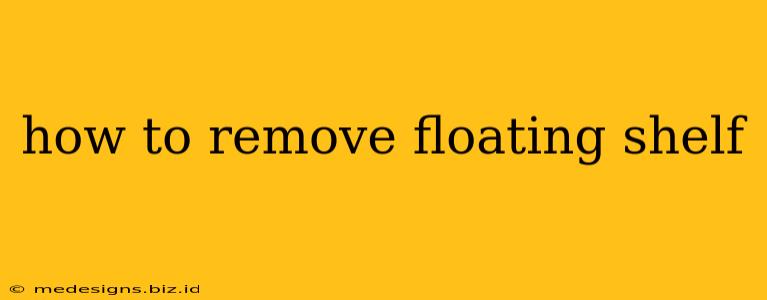Removing a floating shelf might seem daunting, but with the right approach, it's a manageable DIY project. This guide provides a comprehensive, step-by-step process, covering various shelf types and securing methods. Whether your shelf is mounted with brackets, hidden supports, or adhesive, we'll help you get it down safely and efficiently.
Understanding Your Floating Shelf
Before you start, it's crucial to understand how your floating shelf is installed. Different installation methods require different removal techniques. Take a close look at your shelf to identify:
- Type of Shelf: Is it made of wood, glass, metal, or another material? The material will influence the removal process.
- Mounting Method: Look for visible brackets, screws, or any signs of adhesive. Are the supports hidden behind the shelf? This information is key to a successful removal.
- Wall Material: Knowing if your walls are drywall, plaster, concrete, or another material will help determine the best tools and approach.
Tools You'll Need
Gathering the right tools beforehand will make the removal process smoother and safer. You'll likely need some or all of the following:
- Screwdriver (Phillips and Flathead): Essential for removing screws.
- Putty Knife: Helpful for gently prying loose brackets or adhesive.
- Hammer: Might be needed to tap out stubborn brackets or screws.
- Drill (with appropriate drill bit): May be required to remove stubborn screws or anchors.
- Safety Glasses: Protect your eyes from flying debris.
- Work Gloves: Protect your hands.
- Measuring Tape: Useful for assessing the shelf’s size and placement.
- Spackle or Wall Repair Compound: For filling holes left after removing the shelf.
Removing the Floating Shelf: Step-by-Step
Follow these steps, adapting them to your specific shelf and wall type:
1. Identify the Mounting Points: Carefully examine the shelf and the wall behind it to locate all mounting points.
2. Remove Visible Screws or Brackets: If screws or brackets are visible, use the appropriate screwdriver to carefully remove them. Work slowly and steadily to avoid damaging the shelf or wall.
3. Pry Loose Hidden Brackets (if applicable): If the brackets are hidden behind the shelf, you may need to gently pry them loose using a putty knife. Be extremely careful to avoid scratching the shelf or wall. Insert the putty knife between the shelf and the wall and apply gentle pressure.
4. Remove Adhesive (if applicable): For shelves mounted with adhesive, you may need a putty knife or a heat gun to soften the adhesive. Work slowly and methodically, applying heat in short bursts and frequently checking to see if the adhesive is loosening. Always follow the manufacturer's instructions for the adhesive used.
5. Lower the Shelf Carefully: Once the brackets or adhesive are loosened, carefully lower the shelf. Have a helper to support the shelf, especially if it's heavy or large.
6. Remove Anchors or Plugs (if applicable): Once the shelf is down, remove any wall anchors or plugs left in the wall. Use the appropriate tool for your wall type.
7. Repair the Wall: Fill any holes left by screws, brackets, or anchors with spackle or a similar wall repair compound. Allow the compound to dry completely before painting or redecorating.
Troubleshooting Common Issues
-
Stuck Screws: If a screw is stuck, try lubricating it with WD-40 or a similar product before attempting to remove it. If it still won’t budge, you may need to use a drill to remove it.
-
Damaged Drywall: If the drywall is damaged during removal, repair it with spackle and sanding before painting.
-
Broken Shelf: If the shelf breaks during removal, contact a professional for replacement or repairs.
Safety First!
- Always wear safety glasses and work gloves.
- If the shelf is heavy or you're unsure about any step, ask for help.
- Use caution when working with sharp tools or power tools.
By following these steps and taking necessary precautions, you can safely and successfully remove your floating shelf. Remember, patience is key, and if you encounter any significant difficulties, it's always best to consult a professional.
